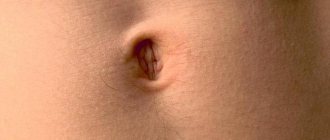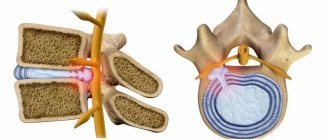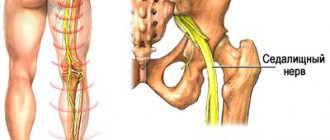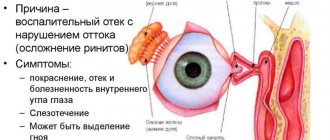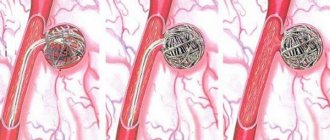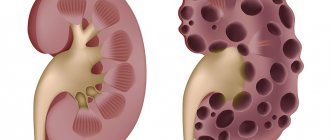Incarcerated hernia is the most common and most dangerous complication that can develop during the formation of a hernial sac of any location. Pathology develops regardless of a person’s age category. The main factor leading to pinching is an increase in intra-abdominal pressure or sudden lifting of heavy objects. However, a large number of other pathological and physiological sources may also contribute to this.
Online consultation on the disease “Strangulated Hernia”. Ask a question to the specialists for free: Surgeon.
- Etiology
- Classification
- Symptoms
- Diagnostics
- Treatment
- Possible complications
- Prevention and prognosis
The clinical picture consists of quite specific symptoms, including: irreducibility of the hernial protrusion, pain of varying degrees of intensity and an increase in the size of the defect.
Pathology can be diagnosed using information obtained after studying the life history, data from an objective examination and instrumental examinations of the patient.
Treatment of a hiatal hernia or any pathology of any other location is carried out only through a hernia excision operation, during which resection of the contents of the sac can also be performed.
The International Classification of Diseases identifies several codes for such a disease. It follows from this that the ICD-10 code will be K40.3-K45.8.
Etiology
Regardless of where the pinched hernia is localized, the mechanism of development of the pathology will be similar for all options. In such situations, a process of compression of the tissues of the internal organs that enter the cavity of the hernial sac occurs.
All hernias include the following components:
- gate - is a weakened hole in the ligaments or muscles;
- the bag is the cavity into which the internal organs directly fall;
- hernial contents are part of the organs penetrating into the pathological opening that forms between the ligaments. In the vast majority of situations, the constituent parts of the hernial sac are intestinal loops, the greater omentum, as well as part of the stomach or bladder, which cannot independently return to their normal anatomical location.
Components of a hernia
The main reason affecting hernia strangulation is an increase in intra-abdominal pressure, which, in turn, can be caused by:
- severe straining during bowel movements;
- coughing or sneezing;
- sudden lifting of weights;
- disturbance of the urination process;
- weakness of the abdominal muscles;
- traumatic injury to the abdomen;
- a sharp decrease in body weight;
- intestinal atony, esophagitis and other gastroenterological diseases;
- intense crying or loud screaming - these are the fundamental sources of strangulation of the abdominal hernia in the navel area in children;
- difficult course of labor;
- the patient has any stage of obesity;
- wearing excessively tight belts or belts.
After intra-abdominal pressure returns to normal, a decrease in the size of the hernial orifice is observed, against the background of which the process of pinching of internal organs that extend beyond the hernia occurs. It is worth noting that the probability of the formation of such a process does not depend on the diameter of the gate of the pathological protrusion and its size.
General information
Part of the abdominal wall is the muscular aponeurotic region, which consists of connective tissue. This zone can be called the most vulnerable, since its thickness in some places is less than in other parts of the wall. When unfavorable factors coincide, the integrity of the aponeurosis is disrupted. At first the hole is microscopic in size, but under pressure from the abdominal organs it begins to expand. As a result, nearby organs may fall into it. Considering the anatomy of the human body, in most cases the hernia contains elements of the omentum, small or sigmoid intestine.
It consists of three components - the gate, the bag and the contents. The hernial orifice is precisely the area of the aponeurosis in which the hole appeared. The hernial sac is formed from the parietal tissue of the abdominal wall, which stretches under the influence of the weight of the internal organs and falls into the lumen. Contents – organs that fill the hernia cavity.
Classification
Types of the disease depending on the location of the bag:
- strangulation of the umbilical hernia, which is most often diagnosed in children;
- strangulation of an inguinal hernia - this also includes the development of an inguinal-scrotal hernia in males;
- strangulation of diaphragmatic hernia;
- strangulation of the femoral hernia, which is very important to differentiate from the inguinal hernia sac. This is due to the fact that such diseases have an almost similar clinical picture;
- strangulation of a hernia of the white line of the abdomen;
- strangulation of a postoperative ventral hernia—diagnosed most rarely;
- strangulation of a Spigelian or semilunar hernia - in this case, the focus is located on the line that connects the navel to the anterior upper part of the ilium;
- strangulation of lumbar hernia;
- strangulated sciatic hernia;
- strangulation of the obturator hernia.
Depending on the degree of blockage of the lumen, the disease is:
- full;
- incomplete, which is also called parietal strangulated hernia;
- open - this variant of the disease is possible only when the appendage of the cecum or Meckel's diverticulum is strangulated.
Depending on the characteristics of development, strangulated hernia is divided into:
- antegrade;
- retrograde;
- false or imaginary;
- sudden.
According to the mechanism of formation, strangulated inguinal hernia in men, women and children, just like any other, exists in 4 types. Thus, we distinguish:
- elastic incarceration - formed against the background of a sudden increase in pressure inside the abdominal cavity, which causes oxygen starvation and death of the tissues of the contents of the sac;
- fecal strangulation of a hernia - occurs in cases of overcrowding of the intestinal loop inside the protrusion with feces. In this case, a disruption of the circulatory process occurs, a disorder of intestinal motor function and the development of adhesions;
- retrograde infringement - occurs when several internal organs are involved in the pathology;
- Richter strangulation of a hernia - in this case, only the edge of one or another internal organ located in the hernial sac is strangulated.
Some patients develop mixed entrapment.
In addition, strangulated hernia occurs:
- primary;
- secondary.
According to the distribution of pathological protrusion, the disease can be:
- external - this includes inguinal, umbilical, femoral and Spigelian hernia;
- internal - this category includes supradiaphragmatic, subphrenic, intraabdominal, epigastric and pelvic hernial sac.
Symptoms of a ventral hernia
- A protrusion that forms in the area of a postoperative wound on the anterior wall of the peritoneum. It is localized along the line of the existing scar.
- If the hernia has appeared recently, then it can be repaired; the person does not experience pain in the early stages.
- Pain in the area of the protrusion appears as the pathology progresses. They can occur during heavy lifting, straining and sudden movements.
- If the hernia is not treated, the pain becomes constant and its character is cramping.
- If a hernia forms in the suprapubic region, then disturbances in the urination process are possible.
- Hyperemia of the skin, increased body temperature, gastrointestinal disorders (nausea, vomiting, increased gas formation), the appearance of blood in the stool - these symptoms appear when the ventral protrusion is infringed or when other complications develop.
Symptoms
Clinical manifestations will differ slightly depending on which hernia is pinched. However, in all cases, the first and main symptom, against which additional symptoms develop, is pain, which can have varying degrees of intensity.
The following manifestations are typical for strangulated umbilical hernia:
- increase in abdominal size;
- redness and swelling of the skin surrounding the hernial sac;
- increase in local temperature;
- fever;
- nausea and vomiting - vomit may smell like feces;
- violation of the act of defecation;
- lack of gas discharge due to intestinal obstruction;
- the presence of blood impurities in feces;
- weakness of the body;
- tingling in the hernial sac;
- migraine;
- straining of the bulge;
- blood pressure fluctuations.
Signs of a strangulated hernia
Signs of a strangulated inguinal hernia include:
- pain shock;
- increased heart rate;
- decreased blood tone;
- retention of stool and gases;
- bloating;
- one-time vomiting;
- pale skin;
- anxiety;
- spread of pain to the epigastric region, groin and thighs;
- signs of intoxication.
Symptoms of strangulated hernia of the white line of the abdomen:
- constant nausea with rare vomiting;
- pale skin;
- weakening of the pulse;
- fever;
- flatulence;
- state of shock;
- anxiety and restlessness;
- tension and increase in the volume of the bag.
A strangulated diaphragmatic hernia or hiatal hernia may be indicated by:
- frequent belching;
- regular swelling of the anterior abdominal wall;
- shortness of breath and increased heart rate;
- the appearance of a characteristic rumbling sound;
- nausea and vomiting;
- abdominal asymmetry;
- profuse cold sweat;
- increase in temperature indicators;
- swelling and hyperthermia of the skin around the hernia.
Other types of pathology are relatively rare and have similar symptoms.
It is also very important to remember that a strangulated hernia requires first aid, which includes the following manipulations:
- calling an ambulance;
- providing the victim with a horizontal body position;
- ridding a person of tight clothing;
- applying cold compresses to the forehead;
- providing a small amount of liquid;
- ventilation of the room in which the patient is located.
It is strictly forbidden to adjust the hernial sac on your own, take hot baths, give the patient any medications, or perform gastric lavage.
Strangulated abdominal hernia
A strangulated hernia is a rather unpleasant and dangerous disease when there is compression of organs in the abdominal cavity. This disease almost always leads to a significant decrease in blood flow in the pinched organ and even to cell death.
Reasons for manifestation of infringement
This disease can be caused by a wide variety of reasons.
- Injuries in the abdominal cavity.
- Cough, with pulmonary diseases.
- Disorders of the genitourinary system.
- Constipation, with disorders of the gastrointestinal tract.
- Operative procedures.
Symptoms of infringement
There are several indicative manifestations of this disease.
- “Hard” stomach, sharp pain in the area of the hernia. Even a slight increase in the appearance of a lump is accompanied by severe tension in the abdominal muscles and significant pain.
- Quite severe pain in the peritoneal area. Pain indicators are the main signs of the disease. Pain may appear after intense physical activity. load on the abdominal muscles.
- Bulging. This symptom is manifested by the unexpected appearance of a lump, typical only when a free hernia is strangulated.
- Lack of cough impulse transmission. This manifestation is the most important indicator. The fact is that when pinched, the hernial lump loses contact with the muscles of the peritoneum and becomes completely independent, which leads to a complete absence of the muscle reaction characteristic of coughing.
- Reflex vomiting. This manifestation is also most indicative of this disease. Further, as the process of gastrointestinal obstruction intensifies, vomiting occurs regularly, it appears green in color and has an unpleasant odor.
Types of disease
- Strangulated hernia of the white line of the abdomen. This is a traditional type of hernia strangulation, described in all textbooks, but rarely encountered in life. Much more often, a simple pinched adipose tissue is mistaken for a strangulated hernia.
- Umbilical hernia. This hernia almost always has adhesions, which causes pain, as well as gastrointestinal obstruction. The only reliable indicator for diagnosing this disease is the absence of cough transmission.
Treatment of strangulated hernia
This disease is very dangerous and requires immediate surgical treatment, regardless of the type of hernia and the period of its occurrence. The only contraindication to surgery can be a very serious health condition of the patient.
During the treatment period and after surgery, the most effective and reasonable option would be to prescribe modern restorative drugs, such as gastroenteroprotectors. Gastro-enteroprotectors are compensators for disturbances in the functioning of organs associated with the body’s defense mechanisms.
Diagnostics
Due to the presence of a typical clinical picture, any type of strangulated hernia is diagnosed completely without problems. It follows from this that the correct diagnosis can be made already at the stage of the initial examination, which includes:
- study of medical history;
- analysis of life history - this is necessary to find the cause of a strangulated hernia;
- thorough examination and palpation of the pathological protrusion;
- a detailed survey of the patient - to draw up a complete picture of the course of the disease and determine the severity of symptoms.
Additional instrumental examinations may include:
- Ultrasound of the peritoneum;
- radiography with contrast;
- CT and MRI.
Performing an ultrasound of the abdominal cavity
A strangulated hernia does not require laboratory tests and differential diagnosis.
Treatment
Regardless of the type of course, location and timing of the entrapment, surgical intervention for hernia excision is indicated. Surgery for strangulated hernia must include:
- release of internal organs that have been infringed;
- resection of the hernial sac followed by drainage and suturing of the wound;
- hernioplasty;
- determining the viability of the components of the pathological protrusion - if necessary, excision of necrotic or atrophied areas is carried out.
Surgery can be performed in several ways:
- in an open way;
- Laparoscopically is currently the most preferred technique.
Possible complications
In the case of a strangulated hernia, a person first feels increased pain in this area. A little later, the discomfort is joined by symptoms of classic intestinal obstruction - abdominal pain, vomiting, lack of stool.
When vomit acquires a distinct smell of feces, the body signals a critical condition. Ignoring such signs of pathology can cost a person’s life.
But the most dangerous complication of strangulation is peritonitis, which can develop regardless of which organ fills the hernial sac. The disease is characterized by rapidity and provokes a sharp disruption of the functions of all organs. As a result, multiple organ failure develops, causing cardiac arrest.
Prevention and prognosis
Preventive measures to prevent strangulation of the hernial sac include:
- timely treatment of hernia of any location;
- preventing an increase in intra-abdominal pressure;
- strengthening the abdominal muscles;
- ensuring that body weight is within normal limits;
- refusal to wear tight belts;
- regular preventive examinations at a medical institution.
A timely operation guarantees a favorable outcome of the disease. Late seeking of qualified help or independent attempts to get rid of the infringement lead to the formation of complications. The mortality rate from this disease is approximately 10%.
Treatment and first aid for illness
The most common and, unfortunately, the most dangerous mistake a person makes when a hernia becomes pinched is the desire to independently return the formation to its original state. The feeling of foreignness of the formation and its pain causes an involuntary desire to straighten the protruding tubercle. Such an action is unacceptable. Under no circumstances should such manipulations be performed, as they can lead to the so-called minimal reduction. This condition is described by doctors as a tear of the elastic ring of the hernial orifice and leads to the displacement of the hernia into the peritoneal cavity, without eliminating the infringement itself. In turn, a pinched hernia located in the abdominal cavity causes the accelerated development of peritonitis and the spread of the lesion.
If the previously described symptoms occur, you should immediately seek medical help. A strangulated hernia, which is not treated for a long time, can provoke the development of various ailments. A strangulated hernia can be eliminated exclusively through surgical intervention. In addition, if symptoms of pinching occur, such as constipation, bloating, under no circumstances should you resort to using laxatives or using an enema.
At the time of hospitalization, you must inform the doctor:
- approximate time of onset of the first pain;
- the exact area in which acute pain occurs;
- whether a hernia was previously diagnosed;
- the circumstances under which acute pain occurred;
The occurrence of a pinched hernia is the most painful, dangerous and deadly of all possible complications. Despite the fact that emergency surgery always involves a risk to life, there is no other effective way to remove a strangulated hernia. No other means, including drug treatment, and especially traditional medicine, can solve this problem. If the doctor recommends surgery, it is necessary to make a decision as soon as possible. In case of refusal of surgical intervention, the chance of development of complications, including necrosis and shock, is maximum. If such complications occur, the decision to perform an emergency operation will be delegated to the patient's closest relatives, however, performing surgery in a patient in such a condition significantly increases the risk of death.
During the operation, the surgeon determines the area of infringement, the area and degree of tissue damage, if any, and methods for eliminating the infringement. By seeking medical help and performing surgery as quickly as possible, it is often possible to avoid the removal of tissue sections, which significantly reduces the postoperative rehabilitation period.
